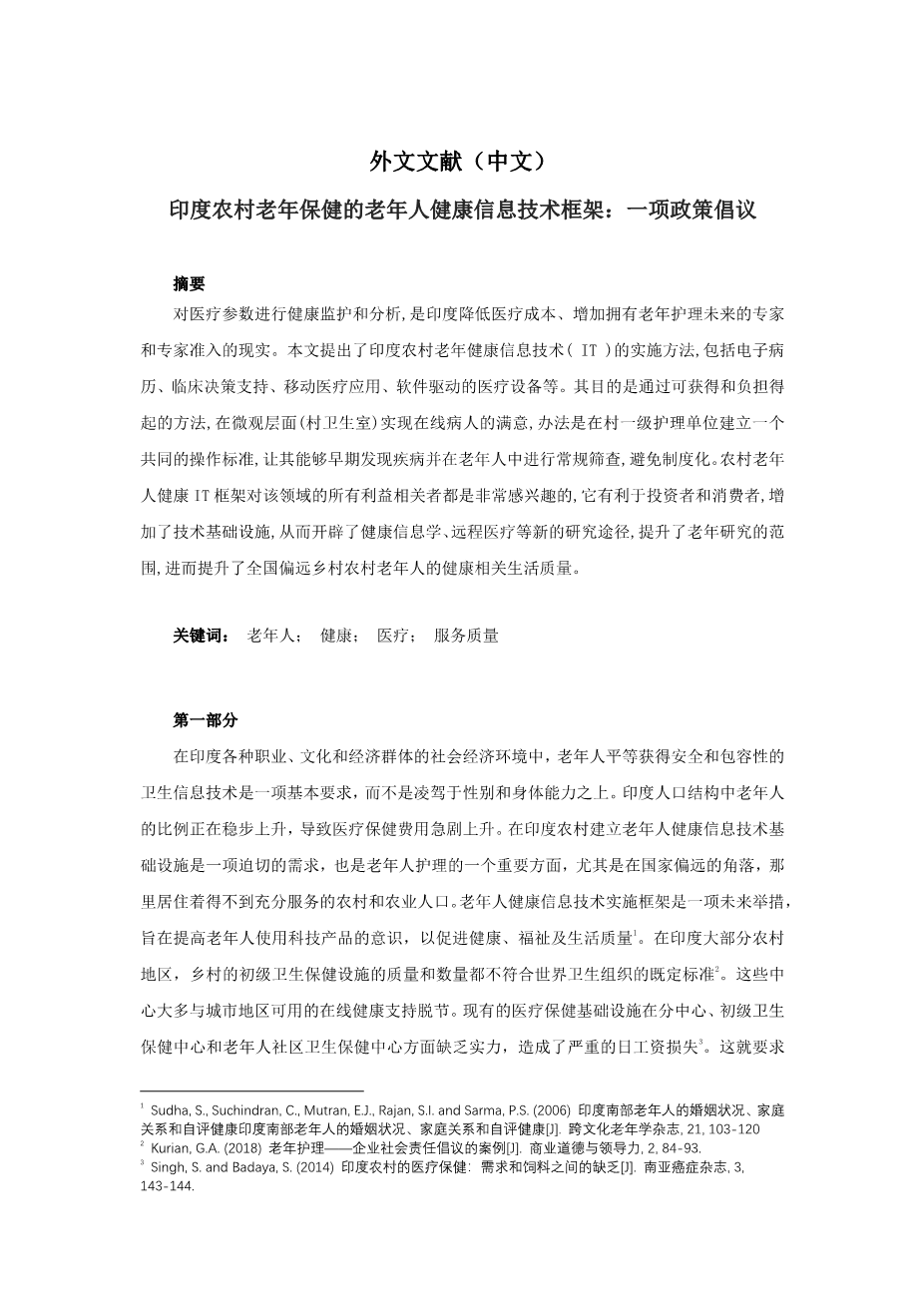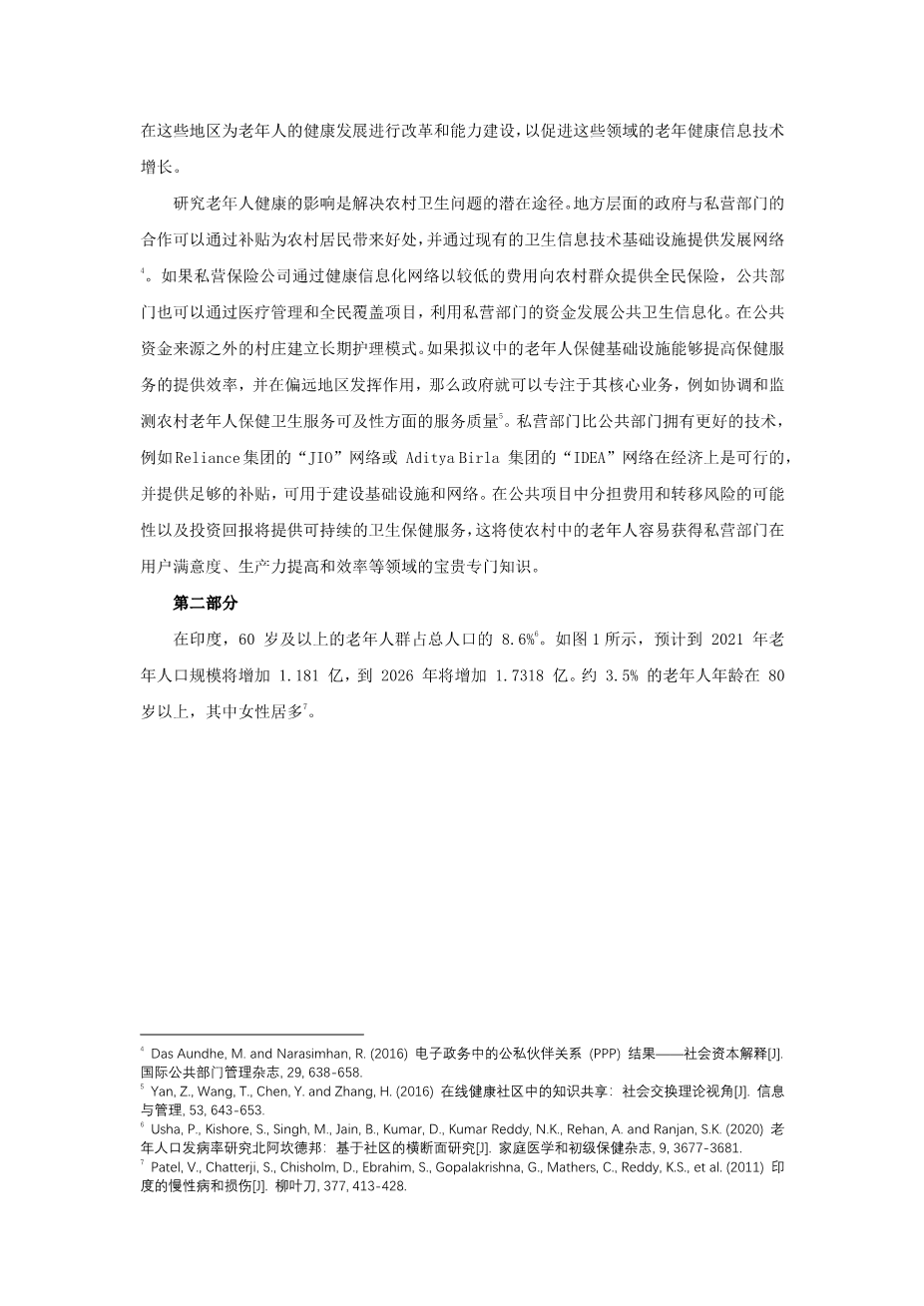外文文献(英文)
The Elder Health Information Technology Framework for Geriatric Care in Rural India: A Policy Initiative
Abstract
Healthcare monitoring and analysis of healthcare parameters is a reality to reduce costs and increase access to specialist and experts that holds the future for geriatric care in India. This paper proposes distinct methods towards the implementation of rural elder health information technologies (IT), which includes electronic medical records, clinical decision support, mobile medical applications, and software driven medical devices used in the diagnosis or treatment of disease for the older adult population in the villages of India. The purpose is online patient satisfaction at the microlevel (village panchayat) through methods accessible and affordable by establishing a common standard of operations at the village primary care units giving way to early disease detection and routine screening among the aged population avoiding institutionalization. The rural elder health IT framework is of great interest for all stakeholders in the field, as it benefits the investors and the consumers, adding to the technological infrastructure, thereby opening new avenues of research in health informatics, telemedicine and enhancing the scope of geriatric research, which in turn enhances the health-related quality of life for the rural older adults in the remote villages of the nation.
Keywords:Older Adults, Elder Health, Eealth Care, Service Quality
Part 1
Equitable access to safe and inclusive health information technology for the older adults is an essential requirement in the socio-economic milieu of India across various occupational, cultural, and economic groups, not overruling gender and physical capabilities. The proportion of older adults in the demography of India is steadily increasing, causing health care costs to rise dramatically. The need for elder health information technology (IT) infrastructural set up in rural India is a pressing need and an important aspect of eldercare especially in the remote corners of the nation, inhabited by the underserved, rural and agrarian population. The elder health IT implementation framework is a future move to enhance the awareness in elderly towards utilization of technology-based devices that promotes health, well-being, and the quality of life[1].The qualitative and quantitative availability of primary health care facilities in the villages does not satisfy the defined standards of the World Health Organization in most parts of rural India[2]. These centers are mostly disconnected from the online health support that is available in the urban areas. The existinghealthcare infrastructure lacks on its strength for sub-centers, primary health centers and community health centers for seniors and procures a heavy daily loss of wages[3].This calls for reforms and capacity development for elder health IT growth in such areas.
The elder health IT Implication is a potential solution to healthcare in the villages. Governmental collaboration at the local level with the private sector can bring benefits for the rural gentry through subsidies and provide for developmental network through the existing health IT infrastructure[4].If the private insurance companies reach out to the rural masses for universal coverage at a lower cost through the health IT network, the public sector can also leverage the private sectorrsquo;s capital for the development of public health IT through the projects on healthcare management and universal coverage for long term care model in the villages outside of public funding sources. If the proposed elder health IT infrastructure fosters health service delivery efficiency and is effective in the remote areas, the government can focus on its core business such as coordination and monitoring the service quality in terms of healthcare accessibility for rural seniors[5]. The private sector has better technology than the public sector, for example, the Reliance group “JIO” network or the Aditya Birla group “IDEA” network is economically viable and provides adequate subsidies that could be used to build the infrastructure and network. The possibility of cost-sharing and risk transfer in public projects, with a return on investment would provide for sustainable health care, which would give the older adults in the villages, easy access to the invaluable expertise of the private sector in the areas of user satisfaction, productivity gains and efficiency.
Part2
In India, the geriatric age group, 60 years and above constitute 8.6% of the total population[6].The projected increase in the size of geriatric population is 118.1 million by 2021 and 173.18 million by 2026 as shown in Figure 1. About 3.5% of the elderly are above 80 years of age, with women in the majority[7].
Figure 1 Projections of the aging population of India, now and the future. Source: Population India. Chapter-2.Census of India 2010.SRS report.
This groupis socially vulnerable and in need of assistive technologies to keep them engaged and connected to health care services. The use of mHealth to resolve health issues can bring about a change towards affordable and accessible health care for the minority (2.4%) of the elderly living alone that constitutes 3.49% of women and 1.42% of men[8].
In rural India, healthcare resources an
剩余内容已隐藏,支付完成后下载完整资料


英语译文共 4 页,剩余内容已隐藏,支付完成后下载完整资料
资料编号:[591229],资料为PDF文档或Word文档,PDF文档可免费转换为Word


